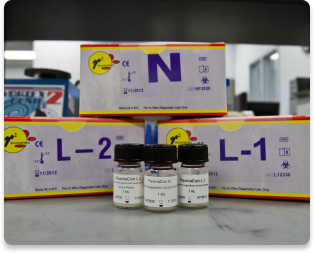PlasmaCon N, L1, and L2
Assay Type
Description
Intended Use
PlasmaCon N is a human lyophilized plasma control intended for use as a normal control with citrated plasma to monitor the performance of the Prothrombin Time (PT) and Activated Partial Thromboplastin Time (APTT) tests.
PlasmaCon L-1 is a human lyophilized plasma control intended for use as a mid-level abnormal control with citrated plasma to monitor the performance of the Prothrombin Time (PT) and Activated Partial Thromboplastin Time (APTT) tests.
PlasmaCon L-2 is a human lyophilized plasma control intended for use as a high level abnormal control with citrated plasma to monitor the performance of the Prothrombin Time (PT) and Activated Partial Thromboplastin Time (APTT) tests.
Uses

Ordering Information
| Catalog # | Product | Kit Configuration | Regulatory Classification | Product Insert (PDF) |
|---|---|---|---|---|
| 30-201 | PlasmaCon N | 10 x 1 mL | 510(k), CE | LL-4510_L PCon N |
| 31-201 | PlasmaCon L1 | 10 x 1 mL | 510(k), CE | LL-4511_L PCon L1 |
| 32-201 | PlasmaCon L2 | 10 x 1 mL | 510(k), CE | LL-4512_L PCon L2 |
Principle of the Test
All laboratory assays require internal quality control (QC) as a component of the laboratory’s Quality Assurance program. Control ranges are determined with each lot change of reagent, with each lot change of control, and with major service of the instrument. Thereafter controls are run according to the requirements of the Clinical Laboratory Improvement Amendments. Currently the minimum requirement is two levels of control run every 24 hours; laboratories should consult the current CLIA or ISO regulations and the reagent manufacturers’ recommendations when they design their internal QC programs.
PlasmaCon control plasmas provide the laboratory a two or three level set of controls for its daily QC of its PT and APTT reagents. PlasmaCon control plasmas are manufactured from pooled plasma to which buffers and stabilizers have been added. PlasmaCon N is manufactured from pooled normal plasma. PlasmaCon L1 and L2 are manufactured from pooled plasma that is selectively depleted of various clotting factors, creating abnormal plasmas of different severities.
Handbooks and Guidelines
-
Handbooks and Guidelines
- Westgard J, Basic QC Practices: Third Edition, Westgard QC Inc., 2010.
- Kitchen S, Olson J, and Preston F, Chapter 5 “Internal Quality Control”, in Quality in Laboratory Hemostasis and Thrombosis, Kitchen, Olson, and Preston ed., Wiley-Blackwell, 2009.
- CLIA 88 current regulations: http://wwwn.cdc.gov/clia/regs/toc.aspx.
- Westgard J., et. al., CLIA Final Rules for Quality Systems, Westgard QC Inc., 2004.
- ISO 15189 “Medical laboratories — Particular requirements for quality and competence”, International Organization for Standardization, http://www.iso.org/iso/iso_catalogue/catalogue_ics/catalogue_detail_ics….
- Clinical Laboratory Standards Institute, “Quality Management System: A Model for Laboratory Services; Approved Guideline—Fourth Edition”, CLSI document GP26-A4, 2011.
- Clinical Laboratory Standards Institute, “One-Stage Prothrombin Time (PT) Test and Activated Partial Thromboplastin Time (APTT) Test; Approved Guideline – Second Edition”, CLSI document H47-A2, 2008.
